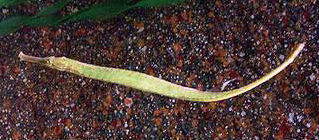Life Cycle and Duties of Pipefish

Pipefish is also known as Syngnathinae. Pipe fish belongs to the subfamily of small fishes like seahorses.
The structure of pipefishThe structure of a pipefish is a straight body like seahorse. Pipe fish resembles like seahorse because its mouth looks like seahorse. The pipe fish name is derived from the figure of nose is denoted like seahorse. Pipefish structure is also like snake top to bottom is narrow and thin. Pipefish is toothless fish. Its skeleton is unbreakable this skeleton is made up of so many edges and the vertical section of the body looks sharp.
In pipe fish the dorsal fin is present, the ventral fins always absent and few more fins not grown up. In pipefish the gills is too small and it is located by the upper angle of the gill.
Many of the Pipefishes are weak swimmers in open water and fresh water. In marine they can move rapidly with help of dorsal fin. In rare cases of pipefish have their own tails and with the help of tails it can move one place to another easily because of the caudal fin they can easily move in sea water. If caudal fin is present to pipefish they are said to be flag tail pipefish. The flag tail pipefish swims easily in all waters.
Reproduction of pipefishPipefishes likes to parenting with the seahorse family the duties is done by the male pipefish of the family. The operation is planned before itself and will be executed in time. Pair bonding is present in new varieties of Pipefishes.
In Pipefishes the eggs are formed in different places of Pipefishes. In some of the fishes the eggs formed in the spongy skin until, unless the eggs get hatched, in other Pipefishes the eggs were segmented in the developed pouch. In pipefish there is a patch or a pouch is present under the tail of pipefish. Different varieties of pipefish mate with 2 or more different species of Pipefishes. So it leads to form more Pipefishes and many of the fishes group is comes under the family of Pipefishes. So many eggs hatch at the same time and the family become the new species of pipefish. All fish is resembles like seahorse with the tiny mouth.
The newly born fishes were independent and the little fishes have no yolk pouches. Some of them catch the small larval stage fish and destroy the some of them use the larvae for plankton. Other larvae are used for small versions of parenting. The character is transmitted from the hereditary of parents.
Ecology and range:Pipefish stays in many places like coral reefs, see grass beds, sandy lagoons the remaining pipefish stays in salty or freshwater with the help of caudal fin which helps the pipefish to dive frequently in both salt water and freshwater. The pipefish can grow up to 12 inches with the color of green and brownish color body. The pipefish feeding habit is small ghost shrimp, brine shrimp or mysis these are the feeding capacity of pipefish.
 Deep Sea Crabs
Deep Sea Crabs